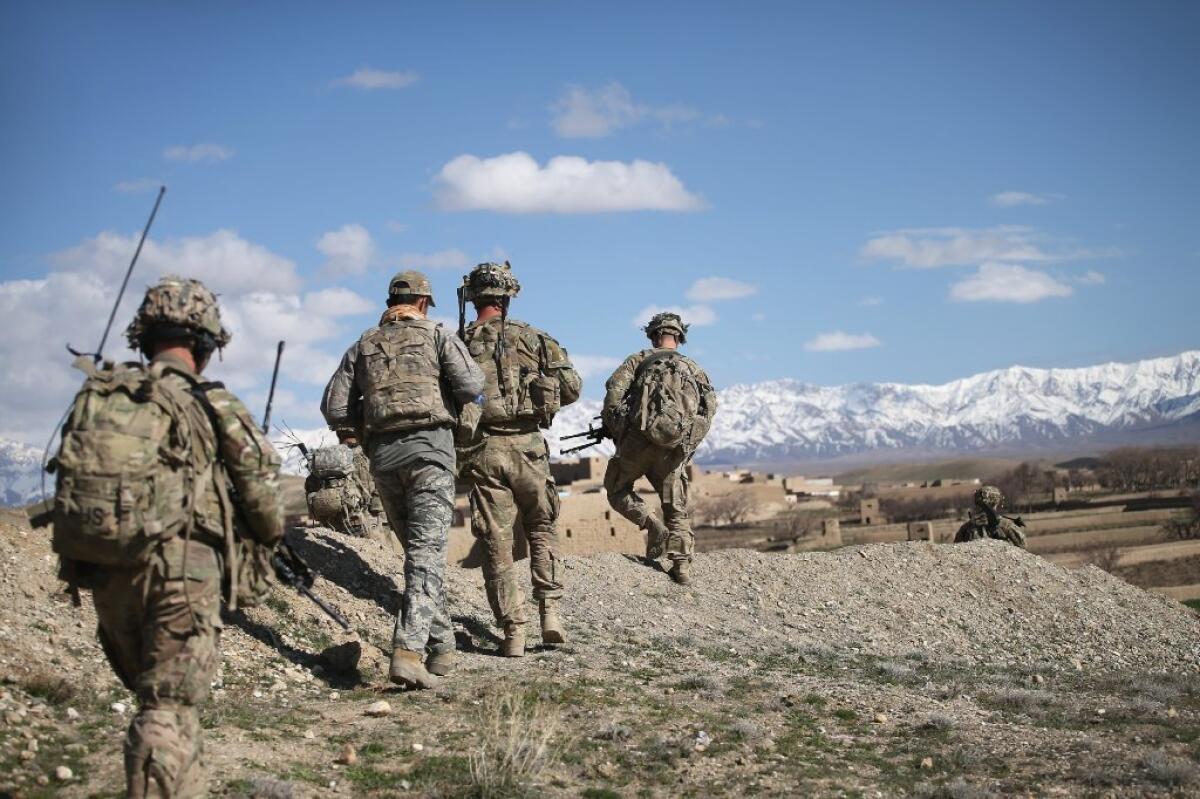New tool can identify soldiers most likely to commit violent crimes, study shows

U.S. Army soldiers patrol an area in Afghanistan last year. Researchers say they have devised an algorithm that predicts which soldiers are at the greatest risk of committing a violent crime.
- Share via
In the science fiction thriller “Minority Report,” a police force known as PreCrime uses mutated human psychics to identify criminals before they act.
The U.S. Army is working toward a similar goal — not by reading minds but by crunching data.
Using the military records of all 975,057 soldiers who served during a six-year period, researchers have developed an algorithm they hope can help prevent severe, violent crimes by identifying those at greatest risk of becoming perpetrators.
They would not be pre-arrested, but rather given counseling or other interventions aimed at heading off violence.
The researchers drew on 38 databases containing information on 446 variables for each solider who served between 2004 and 2009. During that period, 5,771 soldiers committed murder, manslaughter, kidnapping, robbery or other violent felonies. (Domestic violence and sex crimes were not included in the study because research suggests that they follow risk patterns that are distinct from other types of offenses.)
Using a technique known as machine learning, researchers looked for patterns among the violent offenders and used what they found to create a risk model that took account of their demographic characteristics, health histories, career details and other factors predating their crimes.
For men, who accounted for the vast majority of both soldiers and offenders, 24 factors were found to be at play. Those most at risk were young, poor, ethnic minorities with low ranks, disciplinary trouble, a suicide attempt and a recent demotion, according to a report published Tuesday in the journal Psychological Medicine.
The highest-risk group — just 5% of the total population of male soldiers — accounted for 36% of the crimes perpetrated by men, the researchers found. Each year, on average, 15 of every 1,000 of those men committed a violent offense. That was more than seven times the overall rate for male soldiers.
The highest-risk female soldiers were responsible for 33% of crimes perpetrated by women, who overall were about half as likely as men to commit violent offenses.
The algorithm developed to assess their risk differed slightly from the one for men.
To test their model, researchers applied it to a sample of 43,248 soldiers who served between 2011 and 2013. They found that the 5% identified as most at-risk were responsible for 51% of the violent crimes committed by those soldiers.
The tool gives the Army the ability “to identify high-risk soldiers without carrying out expensive one-on-one clinical assessments,” said Harvard psychologist Anthony Rosellini, the study’s lead author.
While violence prevention training is standard for all soldiers, the algorithm could allow the Army to determine who should receive more intensive risk evaluations or interventions, the researchers wrote.
If the new analytical tool can be validated in more tests, the Army still will have to figure out how to use it.
There is still much debate about how to redirect people prone to violence. Even in the highest-risk group, most people do not become offenders.
An intensive violence-prevention program “would make sense only if the interventions are shown to be highly efficient — something that has not yet been demonstrated,” said study co-author John Monahan, a law professor at the University of Virginia.
The study, part of a massive research effort funded by the Army, builds on a paper published last year that used the same method to create a tool for identifying soldiers at greatest risk of suicide.
Ronald Kessler, a Harvard sociologist and co-author, said the team also is working on an algorithm for determining who is most likely to commit sexual assaults and who is at the greatest risk of becoming a victim.
“The military has extraordinary data systems,” he said. “There is an ability to do this targeting in a way that can’t be done anywhere else.”
Follow me on Twitter @AlanZarembo and “like” Los Angeles Times Science & Health on Facebook.






